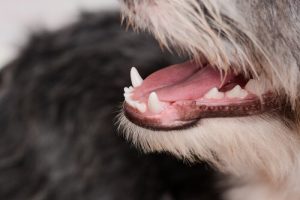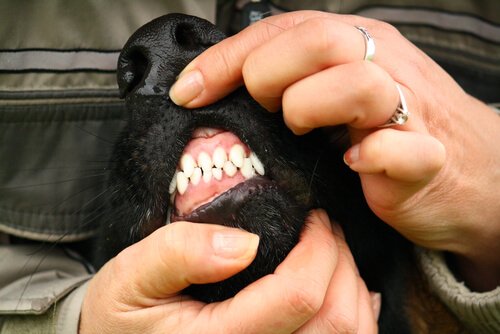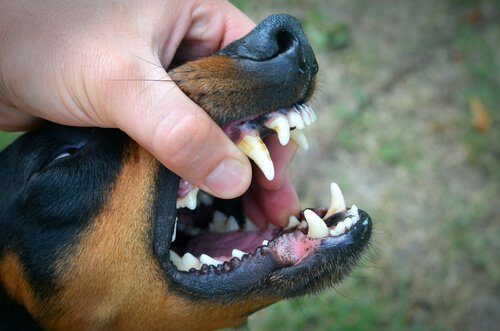What the Color of Your Dog's Gums Can Tell You

Good oral hygiene is essential for your dog’s health. There are tons of diseases that can be transmitted orally, which is just one of the many reasons it’s so important to take good care of your pet’s oral health. The color of your dog’s gums can tell you a lot about how your dog’s health. Continue reading this article to learn about everything you need to know about this topic right now.
How to tell what the color of your dog’s gums means
Before trying figure out what the color of your dog’s gums is telling you, you need to learn how to examine them properly. It’s important to know how to distinguish the different tones. Look at the tips below:
- Determine what color indicates that your dog is healthy. Every dog has a different color in their gums. The tone of a dog’s gums changes when he’s sick or malnourished. So don’t wait for your dog to get sick to figure out what’s happening! Make an effort to learn color of his gums before anything bad happens.
- Check for any changes in color. Their gums don’t have to turn completely white to indicate something is wrong. They might just go down a couple tones, which would mean something is making them pale.
- Check for any spots on their gums. Some dogs have small brown spots on their tongue and gums. There is no need to worry about it because it’s perfectly normal. It would only be bad if they didn’t have them before and then they suddenly appeared. That’s why knowing what your dog’s gums look like is so important.
- The rule of thumb of having healthy gums is that they should be wet, smooth, and without any bulges. Unhealthy gums are usually wrinkly, dry, and sticky.

Once you have a good idea regarding the state and color of your dog’s gums, you need to figure out why his gums are going through changes. Gums have several tones, and each one means something different.
What healthy gums should look like
Healthy gums should have a pinkish tone. When they’re that color, it means your dog’s blood pressure is good, and that he has all the vitamins and nutrients his body requires.
They should be shiny, soft, and not sticky at all. Use your finger to press onto your dog’s gums, if they return to their normal color within a couple seconds, then their blood is circulating properly and there’s nothing to worry about.

The color of your dog’s gums
There are several tones your dog’s gums can take on, such as the ones below:
- White. When your dog’s gums turn this color, it can mean a few things. For example, anemia, poisoning, or babesiosis. However, none of these problems are fatal if you treat them in a timely manner. So, if you see a change in color of your dog’s gums, don’t hesitate to rush to the vet.
- Pale. If your dog’s gums seem like they’ve lost some color, but aren’t quite white, this might indicate internal bleeding, bruising, low blood pressure, or other diseases. If your dog’s gums are pale, then go immediately to the vet.
- Deep red. If you see your dog’s gums have turned deep red, they might be having a heat stroke. He’ll become dehydrated if you don’t act fast.
- Yellow. This color might indicate jaundice, which turns their skin yellow. It’s not terribly serious, but it’s not normal, so it’s a good idea to have it under control.
- Blue. This is an extremely dangerous color because it means they don’t have enough oxygen in their blood. Don’t even wait a single second, just go straight to the vet. Your dog might be having a stroke or an aneurysm.
As you can see, the color of your dog’s gums can tell you a lot more about their health than you might have thought. That’s why it’s so important for you to be very familiar with the color of his gums. If you are, you’ll be well-prepared for any color changes and ready to act fast.
Good oral hygiene is essential for your dog’s health. There are tons of diseases that can be transmitted orally, which is just one of the many reasons it’s so important to take good care of your pet’s oral health. The color of your dog’s gums can tell you a lot about how your dog’s health. Continue reading this article to learn about everything you need to know about this topic right now.
How to tell what the color of your dog’s gums means
Before trying figure out what the color of your dog’s gums is telling you, you need to learn how to examine them properly. It’s important to know how to distinguish the different tones. Look at the tips below:
- Determine what color indicates that your dog is healthy. Every dog has a different color in their gums. The tone of a dog’s gums changes when he’s sick or malnourished. So don’t wait for your dog to get sick to figure out what’s happening! Make an effort to learn color of his gums before anything bad happens.
- Check for any changes in color. Their gums don’t have to turn completely white to indicate something is wrong. They might just go down a couple tones, which would mean something is making them pale.
- Check for any spots on their gums. Some dogs have small brown spots on their tongue and gums. There is no need to worry about it because it’s perfectly normal. It would only be bad if they didn’t have them before and then they suddenly appeared. That’s why knowing what your dog’s gums look like is so important.
- The rule of thumb of having healthy gums is that they should be wet, smooth, and without any bulges. Unhealthy gums are usually wrinkly, dry, and sticky.

Once you have a good idea regarding the state and color of your dog’s gums, you need to figure out why his gums are going through changes. Gums have several tones, and each one means something different.
What healthy gums should look like
Healthy gums should have a pinkish tone. When they’re that color, it means your dog’s blood pressure is good, and that he has all the vitamins and nutrients his body requires.
They should be shiny, soft, and not sticky at all. Use your finger to press onto your dog’s gums, if they return to their normal color within a couple seconds, then their blood is circulating properly and there’s nothing to worry about.

The color of your dog’s gums
There are several tones your dog’s gums can take on, such as the ones below:
- White. When your dog’s gums turn this color, it can mean a few things. For example, anemia, poisoning, or babesiosis. However, none of these problems are fatal if you treat them in a timely manner. So, if you see a change in color of your dog’s gums, don’t hesitate to rush to the vet.
- Pale. If your dog’s gums seem like they’ve lost some color, but aren’t quite white, this might indicate internal bleeding, bruising, low blood pressure, or other diseases. If your dog’s gums are pale, then go immediately to the vet.
- Deep red. If you see your dog’s gums have turned deep red, they might be having a heat stroke. He’ll become dehydrated if you don’t act fast.
- Yellow. This color might indicate jaundice, which turns their skin yellow. It’s not terribly serious, but it’s not normal, so it’s a good idea to have it under control.
- Blue. This is an extremely dangerous color because it means they don’t have enough oxygen in their blood. Don’t even wait a single second, just go straight to the vet. Your dog might be having a stroke or an aneurysm.
As you can see, the color of your dog’s gums can tell you a lot more about their health than you might have thought. That’s why it’s so important for you to be very familiar with the color of his gums. If you are, you’ll be well-prepared for any color changes and ready to act fast.
This text is provided for informational purposes only and does not replace consultation with a professional. If in doubt, consult your specialist.







